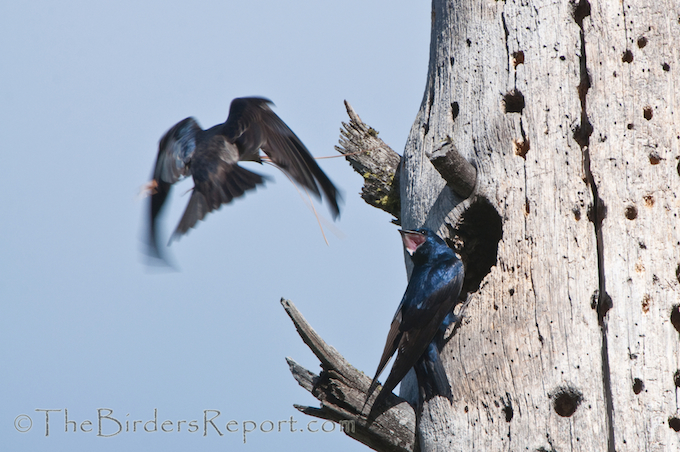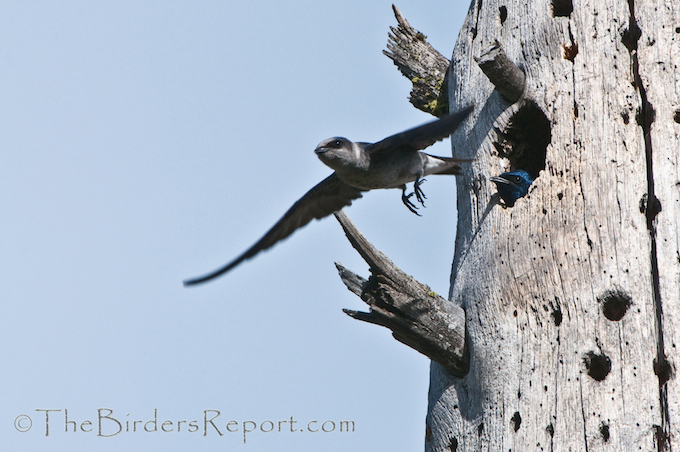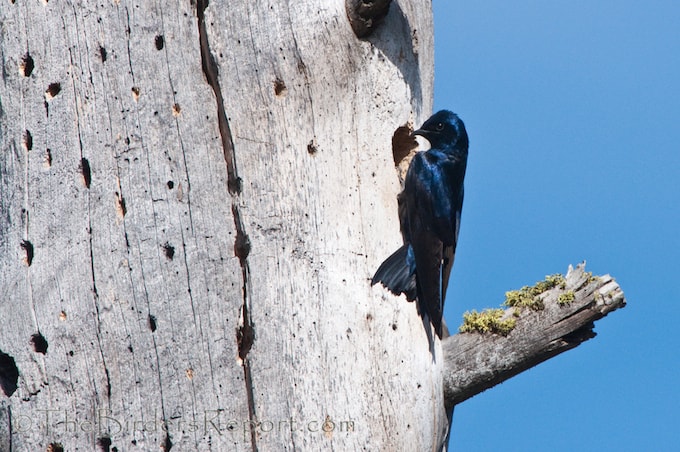The Purple Martin (Progne subis) is a well known and popular bird in eastern North America where it breeds almost entirely in human-made martin houses. Only a few records of natural nestings east of the Rocky Mountains have been reported during the twentieth century1. Here in western North America however, where Purple Martins are less common, they nest almost exclusively in woodpecker holes or natural cavities.


The Purple Martin is the largest swallow in North America and among the largest in the world, their diet consisting exclusively of flying insects.
Most migrate north in early spring via the Central American isthmus between North and South America.

As a secondary-cavity nester, the Purple Martin has also suffered from the introduction into North America of European Starlings and House Sparrows, which compete with it for nest sites throughout much of the eastern half of the continent. Without human intervention and management of these colony sites, starlings and sparrows can cause local extinction of martins by appropriating their nest cavities and making them permanently unsuitable for martin use1.

The problem is certainly diminished in the western Purple Martin population since this group nests solitarily in its more traditional natural cavity in the wild.

Since these birds are rather scarce in central northern California where I live (note the tiny red splotch on the map above) , I was delighted to be informed of this breeding pair by another local birding friend.

Observing this pair from a safe distance with a super telephoto lens allowed me to get these photographs without disturbing the bird’s natural behavior. I watched as the female made several trips for nesting material.

On many of these forays, she was escorted by the male, which is considered to be mate-guarding behavior. He rarely brought back nesting material himself. At other times, the male would simply wait the few minutes that his mate was gone and welcome her at the cavity entrance.

Occasionally, after the female placed the nesting material into the cavity, in this case pine straw, the male would follow her into the cavity where they would disappear for a few moments. According to Birds of North America Online, in over fourteen years of observation pairs are rarely observed copulating. It is believed that this activity probably occurs within the nest cavity. From the look on this males face as the female departs, I think this may very well be the case.

Here the male has just returned following the female back to the nest site from a foray…

and here.

After the female had been in the cavity for awhile, she appeared at the entrance with something in her beak. Apparently she was doing a bit of housekeeping as she dropped, what appeared to be a seedpod of some sort, outside the nest cavity.

I’m not certain about his response.

I must say she certainly is a beauty…

no matter how you look at her.

And I think he enjoys showing off for her too.

I know I certainly enjoyed the show.

This is a film I shot of the pair at the nest site. Make sure you turn the sound up as you will hear not only the Purple Martin male singing but several other bird species in the background including a Common Raven and Mourning Dove. If you can identify some of the other songbirds singing and chattering, please let the rest of us know what they are.
References: 1Birds of North America Online
Larry Jordan
Larry Jordan is an avid birder and amateur photographer living on the Pacific Flyway near the Central Valley of Northern California. He is a board member of his local Audubon Society and is a bird and wildlife conservationist. Larry contributes to several wildlife conservation organizations and is a BirdLife International "Species Champion." He is also Habitat Manager for the Burrowing Owl Conservation Network, an organization dedicated to the protection and restoration of the Western Burrowing Owl population in the United States. Larry has been blogging about birds since September of 2007 at TheBirdersReport.com

Leave a Reply